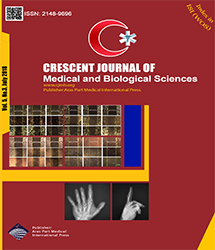| Original Article | |
| Comparing the Efficacy of Surfactant Administration by Laryngeal Mask Airway and Endotracheal Intubation in Neonatal Respiratory Distress Syndrome | |
| Manizheh Gharehbaghi1, Yalda Jabbari Moghaddam2, Reza Radfar2 | |
| 1Women’s Reproductive Health Research Center, Tabriz University of Medical Sciences, Tabriz, Iran 2Tabriz University of Medical Sciences, Tabriz, Iran |
|
|
CJMB 2018; 5: 222–227 Viewed : 6971 times Downloaded : 4707 times. Keywords : Surfactant administration, Endotracheal intubation, Laryngeal mask, Respiratory distress syndrome |
|
| Full Text(PDF) | Related Articles | |
| Abstract | |
Objectives: This study aimed to compare the effcacy of surfactant administration by laryngeal mask airway (LMA) and endotracheal intubation in the management of respiratory distress syndrome (RDS) in preterm infants. Materials and Methods: In a prospective interventional study in NICU at Al-Zahra hospital, 50 premature infants with gestational age of 33-37 weeks and birth weight of 1800 g or more who needed surfactant replacement therapy for RDS were randomly allocated to 2 groups. Twenty-fve neonates in ETT group received surfactant by endotracheal intubation and the LMA were used for the administration of surfactant in 25 neonates (LMA group). Results: The mean gestational age in LMA group was 32.88±1.32 and it was 33.76±2.12 weeks in ETT group (P=0.15). The mean RDS score was not statistically different 2 two groups, 7.68±0.80 vs. 7.24±1.17 (P=0.79). Mechanical ventilation was needed for 1 neonate in the LMA group and 3 infants in the ETT group (P=0.16). After surfactant administration, the mean FiO Conclusions: Based on our fndings, the LMA may be a safe and effective alternative way for surfactant administration in late preterm infants. Future multicenter studies are recommended for determining safety and effcacy of LMA in preterm infants. |
Cite By, Google Scholar
Online Submission System
 CJMB ENDNOTE ® Style
CJMB ENDNOTE ® Style
 Tutorials
Tutorials
 Publication Charge
Medical and Biological Research Center
About Journal
Publication Charge
Medical and Biological Research Center
About Journal
Aras Part Medical International Press Editor-in-Chief
Arash Khaki
Deputy Editor
Zafer Akan


















